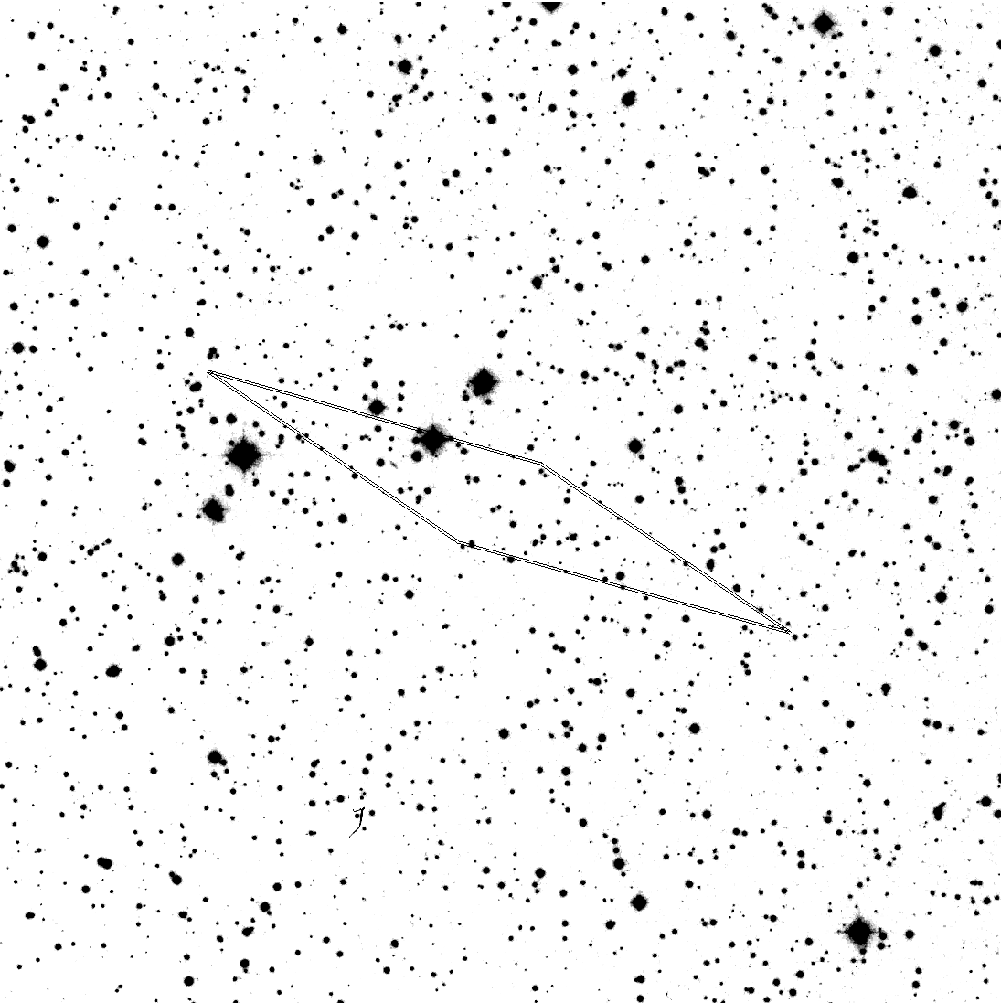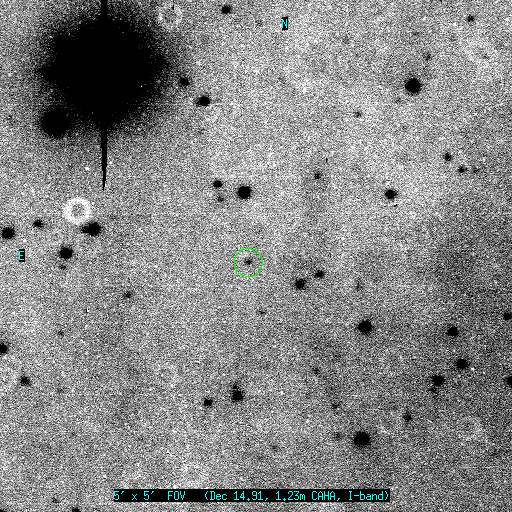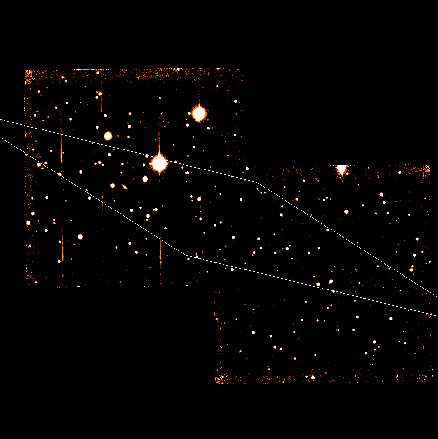- GCN notice #899
K. Hurley, on behalf of the Ulysses GRB team,
T. Cline, on behalf of the Konus-Wind and NEAR GRB teams,
E. Montanari, C. Guidorzi, and F. Frontera, on behalf of the BeppoSAX GRBM team,
and E. Mazets, and S. Golenetskii, on behalf of the KONUS-WIND GRB team, report:
Ulysses, NEAR, and KONUS-WIND observed this GRB at 53846 seconds.
As observed by Ulysses, it had a duration of approximately 70.
seconds, a 25-100 keV fluence of approximately 1.2E-05 erg/cm2,
and a peak flux of approximately 1.3E-06 erg/cm2 s over .25 seconds
We have triangulated it to a, preliminary, 3 sigma error box with approximate area 32.
square arcminutes whose coordinates are:
ERROR BOX CENTER: 6 h 49 m 34.54 s 36 o 22 ' 52.78 "
ERROR BOX CORNER 1: 6 h 49 m 40.68 s 36 o 21 ' 37.66 "
ERROR BOX CORNER 2: 6 h 48 m 49.32 s 36 o 19 ' 4.79 "
ERROR BOX CORNER 3: 6 h 50 m 20.11 s 36 o 26 ' 42.07 "
ERROR BOX CORNER 4: 6 h 49 m 28.41 s 36 o 24 ' 7.90 "
This error box may be improved
- red DSS finding chart
ps-file

- GCN notice #900
V. Mohan, Ram Sagar, S.B. Pandey (UPSO, Nainital), and
A. J. Castro-Tirado, IAA-CSIC (Granada) and LAEFF-INTA (Madrid),
on behalf of a larger collaboration,
report:
We have imaged 80% of the error box for GRB 001212 (Hurley et al.,
GCN 899) with the 1.0-m telescope of U.P. State Observatory, Nainital.
4 R-band frames (300-s exposure time each) were obtained on Dec 14.85 UT
(i.e. 53 hours after the GRB). When comparing to the DSS-2 (R-band),
down to a limiting magnitude of R = 21.0, we found an object that
has become brighter by about 1.5 mag. Its position is AR(2000) =
06 49 38.1 Dec(2000) = +36 22 52 (+/- 2"). Follow-up observations are
encouraged in order to confirm whether this is the GRB 001212 optical
counterpart.
 I-band image of the central part of the GRB 001212
error box (Hurley et al. GCN 899) with the object proposed by
Mohan et al. (GCN 900). North is up and East to the left.
I-band image of the central part of the GRB 001212
error box (Hurley et al. GCN 899) with the object proposed by
Mohan et al. (GCN 900). North is up and East to the left.
- GCN notice #901
John E. Gizis, IPAC/Caltech reports:
I have checked the candidate optical counterpart (GCN 900)
for GRB 001212 at RA(2000) = 06 49 38.1 Dec(2000) = +36 22 52 (+/- 2")
against the Two Micron All Sky Survey (2MASS) 2nd Incremental Release.
It is matched by a source observed on 1 April 1998. Source
2MASSI J0649380+362251 has J=15.220 +- 0.058, H=14.603 +- 0.083,
and Ks = 14.341 +- 0.079. These colors are typical for a
mid-M dwarf. Two non-GRB explanations for the observed brightening
of the source are a flare or color terms between the photographic plate
and the CCD. Finding charts and the 2MASS data are available by
entering these coordinates at the web site:
http://irsa.ipac.caltech.edu/
This publication makes use of data products from the Two Micron All Sky
Survey, which is a joint project of the University of Massachusetts
and the Infrared Processing and Analysis Center/California Institute of
Technology, funded by the National Aeronautics and Space Administration
and the National Science Foundation.
- GCN notice #902
R. Ishioka, M. Uemura, K. Matsumoto, H. Iwamatsu, T. Kato (Kyoto Univ.) and
H. Yamaoka (Kyushu Univ.) report on behalf of VSNET-GRB collabolation:
We have observed the central region of the IPN error box of GRB
001212 (GCN 899) with 20 x 30s exposures (no filter) using the 25-cm
telescope at Kyoto under the strong moonlight. The starting time of
the exposure is Dec. 14.64 UT, which is about 2.0 days after the GRB
event. The preliminary reduction yields that the limiting magnitude
of the individual image was mag about 16.0. Comparing with Digital
Sky Survey 2nd generation R image, no new distinct object has been
detected within and around the central region of the error box.
Further analysis will be carried out.
- GCN notice #903
J. Zhu and J. Ma, on behalf of BAO GRB team, report:
We have imaged a 58'*58' field including the complete error box for
GRB 001212 (Hurley et al., GCN 899) with the 0.6/0.9-m Schmidt telescope
of Beijing Astronomical Observatory, Chinese Academy of Sciences. 8 frames
(300-s exposure time each) were obtained between Dec. 14.61 to 14.64
(48 hours after the GRB) with the BATC i-filter (6660 +/- 240 A), under
thin clouds with a nearby bright moon. The images were not in good quality
because of the unstable weather, and photometry at the position of the
possible OA suggested by Mohan et al. (GCN 900) performed on the combination
image of our two images (which in relative good quality) results a detection
of a possible source at RA=06:49:38.19, Dec=+36:22:53.8 (J2000.0) for the
epoch of Dec. 14.631. Assuming R=14.6 for a star at RA=06:49:30.03,
Dec=+36:24:35.5 (J2000.0) gives R=17.4 (+/-1.0) for our detection, which
is almost at the detecting limitation of the image. Follow-up observation
is going to be made at around Dec. 15.6 under same system configurations.
- GCN notice #904
J. Zhu, on behalf of the Beijing Astronomical Observatory GRB team, reports:
The approximately one degree square field centered with GRB 001212 error
box (Hurley et al., GCN 899) was imaged again with the 0.6/0.9-m Schmidt
telescope (Zhu et al., GCN 903) during Dec. 15.51-15.54, 15.69-15.76, and
Dec. 16.56-59 under good weather condition. Three 1200-s exposures
(limiting magnitude for each is about R=21) and nine 600-s exposures were
taken in Dec. 15 and three 960-s exposures in Dec. 16. The source
mentioned by Mohan et al. (GCN 900) was clearly detected in all images,
and there seems to be no obvious variation at the level of photometric
accuracy (0.2-0.3 mag).
Using the following four USNO-A V1.0 objects (David Monet, et. al.)
================================
No. RA (2000.0) Dec mag.
--- ----------------------- ----
1 06:49:30.03 +36:24:35.5 14.6
2 06:49:31.16 +36:23:30.6 14.9
3 06:49:32.45 +36:22:12.1 14.3
4 06:49:32.63 +36:21:06.1 14.1
================================
as our magnitude references (the real procedure is to use R=14.475 for
the average magnitude of the above 4 stars), the magnitudes derived
from each frame are (combined with two previous images mentioned in
GCN 903 for completeness; photometric error is one-sigma):
=============================
Date mag error notes
---- ----- ----- -----------
14.63 17.66 1.52 bad weather
14.64 16.91 0.68 bad weather
15.51 18.69 0.14
15.53 18.72 0.14
15.54 18.39 0.13
15.69 18.39 0.18
15.70 18.60 0.22
15.71 18.97 0.28
15.72 18.55 0.19
15.73 18.82 0.26
15.73 18.64 0.22
15.74 19.20 0.37
15.75 18.71 0.24
15.76 18.64 0.23
16.56 18.84 0.16
16.58 18.58 0.14
16.59 18.57 0.17
=============================
We conclude that this object is not optical afterglow for GRB 001212.
- GCN notice #907
J. Greiner, G. Szokoly (both AIP, Potsdam), J. Eisloeffel, B. Stecklum,
S. Klose (all TLS, Tautenburg), Th. Stanke (MPIfR, Bonn), N. Lodieu,
M. McCaughrean (both AIP, Potsdam), A.J. Castro-Tirado (LAEFF-INTA, Madrid
and IAA-CSIC, Granada), report:
We have observed the error box of GRB 001212 (GCN #899) on Dec. 15, 2000
(2.5 days after the GRB) and Dec. 17, 2000 with the 3.5m telescope of the
German-Spanish Calar Alto Observatory. The observations were done with
the NIR-camera Omega-Prime in the H band. Two adjacent pointings were made
with the 6.5 arcmin FOV camera, covering about 90% of the error box
(see the image at http://www.mpe.mpg.de/~jcg/grb001212.html). Conditions were
non-photometric during the first night.
Photometric calibration of the images was done based on the 2MASS magnitude
of object 2MASS 0649178+362151 having H = (14.45+-0.06) mag (and a USNO R-band
magnitude of 16.1 mag). A comparison of the two epochs of (summed) H-band
images of GRB 001212 reveals no object in the GRB error box which faded by
more than 0.2 mag down to H = 18.3 mag.
-----------------------------------------------------
Date (UT) exposure (min) seeing limiting
(Start) Poin1 Poin2 (arcsec) mag.
-----------------------------------------------------
Dec. 15.1744 32 32 3.0 H = 18.3
Dec. 17.8188 6 7 1.3 H = 18.4
-----------------------------------------------------
The object mentioned by Mohan et al. (GCN #900) which was reported by
Gizis (GCN #901) to have H = (14.603+-0.083) mag based on the April 1, 1998
2MASS scan, was measured with H = (14.45+-0.10) mag and H = (14.50+-0.10) mag
at the two epochs, thus being constant within our measurement errors.
We appreciate the availability of the 2MASS 2nd Incremental catalog at
IPAC/Caltech.

![]() Previous IAU Circulars
Previous IAU Circulars 

